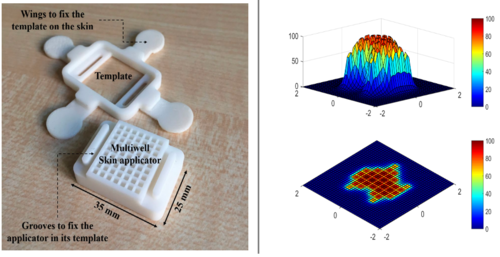Beta radiation therapy of skin tumors
Skin cancer is the most common type of malignancy in the world. While the mainstay treatment for this type of cancer is surgery, it’s not applicable for all patients. Diabetic patients, old patients, and patients whose tumors are located on critical sites with poor vascularity are usually excluded from the surgery. In these cases, radiation therapy is the method of choice that eradicates the tumor by inducing damage, using ionizing radiation, in its cells. There are several radiation therapy tools and techniques out there by which the treatment can be delivered to skin cancer patients. Despite their differences, these tools and techniques share some common drawbacks as follow:
- The setups needed to deliver the treatment are “very expensive”
- The source of radiation is mainly gamma emitters or x-ray tubes which entails building a dedicated “costly shielding room” for the setup to fulfill radiation protection requirements
- The current techniques need “multi-session treatment” schemes (fractionated) to ensure that the dose received by critical structures beneath the tumor is kept below the threshold and give recovery time to these structures
Expensive radiation therapy setup, a need for costly shielding rooms for the setup, and fractionated treatment scheme are the main limitations of the current radiation therapy systems which have been a bottleneck in offering affordable and comfortable treatment for skin cancer patients.
It seems that the use of beta-emitting isotopes, in place of gamma or x-ray sources, as a radiation source for use in skin cancer therapy can help address these challenges and facilitate the transition towards a more affordable and comfortable radiation therapy technique for skin cancer patients. Due to the short range of beta radiation in tissue (normally less than 10mm) and its rapid dose fall-off, the radiation dose from a skin brachytherapy applicator with a beta source will be deposited within the first layers of the skin where the tumor is located. This characteristic of beta radiation may lead to the protection of sensitive structures located right beneath the skin lesion during the radiation therapy procedure. As a result, the treatment dose can be delivered in one session or two, eliminating the need for fractionation of the treatment. This can promise a more conformable treatment than the existing methods for skin cancer patients. Additionally, because of the absorption of the beta radiation in a few centimeter-plastic, the shielding needed for this treatment can be an economical desktop setup. This in turn may lead to a treatment setup that is affordable for hospitals.
- The basic principle of this new technique has been proved on paper, in theory, and partly in simulation. To take the project to the next step, we offer master thesis topics in the following topics;
- Monte Carlo simulation study of the beta radiation therapy of skin tumors in different scenarios
- Radiobiology study of the proposed treatment – in vivo study
If this project interests you, please send us your CV, with your topic of choice, to set up a meeting to discuss the project in more detail and shape it based on your interests.

Fig. 1: Beta source, in cream or gel form is filled in a 3D printed multi-well applicator wells (left image) in an arbitrary pattern mimicking a skin tumor 2D shape to create a tumor-specific dose profile (right image) - simulation study of the proposed concept.






